
Fire damper BSK-RPR-EU
Technical documentation
Description
Construction subject to change
No return possible
Version: 2015-02-01 | Document: 09/48 | Page 2
D
ESCR
IPTION
Fire dampers built into ventilation ducts (air-conditioning
systems) are used for the automatic locking of fire lobbies.
The fire damper BSK-RPR-EU corresponds to EN 15650, EN
13501-3 and EN 1366-2.
BSK-RPR-EU has been tested according to EN 1366-2 in com-
pliance with Declaration of performance no. 09-48-DoP-BSK-
RPR-EU-2013-07-01. It has the EC certificate of conformity
0761 - CPD - 0247. Its category according to EN 13501-3 is EI
120 (v
e
i
↔
o) S. The national standards and guidelines must
be observed along with this technical documentation, instal-
lation, mounting and operating instructions.
For maintenance, servicing, retrofitting, etc., it may be ne-
cessary to provide on-site inspection openings in suspended
ceilings, shaft walls, downstream ventilation ducts, etc. They
must be built in in sufficient numbers and size and must not
impair the functioning of the fire dampers.
The fire dampers must be connected to the ventilation ducts
of the ventilation system either on one or both sides. When
connected on one side, finishing protective gratings made of
non-flammable building materials (EN13501-1) must be pro-
vided on the opposite side. The fire dampers can be connec-
ted to non-flammable or to flammable ventilation ducts.
Housing made of galvanised sheet steel;
optionally (at an extra charge):
Housing made of stainless steel material no.
1.4301 or 1.4571
Housing with DD coating (two-component
top coat based on polyurethane varnish) inside
and/or outside
Extra charge for powder coating (RAL 9010 / pure
white), inside and outside
Model with plug-in connection (-S) or flanged connection
(-F) according to EN 12220 and DIN 24154-1, respec-
tively.
Shut-off damper made of silicate board
Cold and hot leakage requirements according to EN
1366-2 are complied with using circumferential rubber
and intumescent seals.
Horizontal position of the damper blade axle
The installation position is independent of the air flow
direction.
Thermal trigger via fusible link 72°C;
optionally (at an extra charge):
with electrothermal trigger devices (for spring re-
turn actuators)
Use: max. operating pressure of 1000 Pa at v
stirn
≤
10
m/s
Housing leakage class C according to EN 1751
Use or connection of a smoke trigger device with general
building supervisory approval (Germany) (e.g. SCHAKO
smoke detection system RMS, see technical documenta-
tion smoke detection system RMS) in connection with
suitable electric trigger devices of the fire damper is pos-
sible; only trigger devices working according to the "cur-
rentless closed" principle may be connected to the RMS
system; the propagation of fire and smoke is effectively
prevented and the requirements of the Model Building
Regulation (MBO) are fulfilled.
Optimal integration into the building control system by
means of the SCHAKO EasyBus signalling and switching
bus system (see technical documentation EasyBus) or
the fire damper mini-controller BKSYS (see technical
documentation BKSYS).
MAINTENANCE INFORMATION
We point out that only suitable cleaning materials may be
used for cleaning fire dampers in stainless steel design!
ATTENTION
Building installations must be erected, modified and main-
tained in a way to prevent the fire outbreak and propagation
of fire and smoke (propagation of fire) and to allow rescue of
persons and animals and effective fire extinguishing. Smoke
propagation through the ventilation and air-conditioning sys-
tems can be effectively prevented only by means of suitable
electric trigger devices in connection with a smoke detection
system.
We, therefore, recommend fitting the fire dampers, for
example, with electric spring return actuators that can be
triggered by the smoke detector.
GENERAL
Data and requirements according to German standards (DIN)
must be checked on site for compatibility with current stan-
dards and directives in the respective states/countries and
adapted, if necessary. Whether the installation of flexible
connection pieces is required, must be determined on site.























